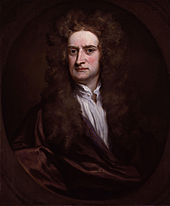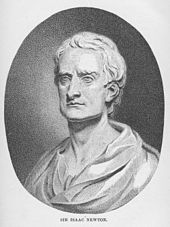| Sir Isaac Newton | |
|---|---|
 Godfrey Kneller's 1689 portrait of Isaac Newton (age 46). |
|
| Born | 25 December 1642 [NS: 4 January 1643][1] Woolsthorpe-by-Colsterworth,Lincolnshire, England |
| Died | 20 March 1727 (aged 84) [OS: 20 March 1726 NS: 31 March 1727][1] Kensington, Middlesex, England |
| Resting place | Westminster Abbey |
| Residence | England |
| Nationality | English (later British) |
| Fields | |
| Institutions | |
| Alma mater | Trinity College, Cambridge |
| Academic advisors | |
| Notable students | |
| Known for | |
| Influences | |
| Influenced | |
| Signature |
|
| Life of Isaac Newton |
|---|
Sir Isaac Newton PRS MP (25 December 1642 – 20 March 1727) was an English physicist and mathematician who is widely regarded as one of the most influential scientists of all time and as a key figure in the scientific revolution. His book Philosophiæ Naturalis Principia Mathematica("Mathematical Principles of Natural Philosophy"), first published in 1687, laid the foundations for most of classical mechanics. Newton also made seminal contributions to optics and, as mathematician, he shares credit with Gottfried Leibniz for the invention of the infinitesimal calculus.
Newton's Principia formulated the laws of motion and universal gravitation that dominated scientists' view of the physical universe for the next three centuries. It also demonstrated that the motion of objects on the Earth and that of celestial bodies could be described by the same principles. By deriving Kepler's laws of planetary motion from his mathematical description of gravity, Newton removed the last doubts about the validity of theheliocentric model of the cosmos.
Newton built the first practical reflecting telescope and developed a theory of colour based on the observation that a prism decomposes white light into the many colours of the visible spectrum. He also formulated an empirical law of cooling and studied the speed of sound. In addition to his work on the calculus, as a mathematician Newton contributed to the study of power series, generalised the binomial theorem to non-integer exponents, and developed Newton's method for approximating the roots of a function.
Newton was a fellow of Trinity College and the second Lucasian Professor of Mathematics at the University of Cambridge. He was a devout but unorthodox Christian and, unusually for a member of the Cambridge faculty, he refused to take holy orders in the Church of England, perhaps because he privately rejected the doctrine of trinitarianism. In addition to his work on the mathematical sciences, Newton also dedicated much of his time to the study of alchemy and biblical chronology, but most of his work in those areas remained unpublished until long after his death. In his later life, Newton became president of the Royal Society. He also served the British government as Warden and Master of the Royal Mint.
Contents[hide] |
Life
Early life
Isaac Newton was born (according to the Julian calendar in use in England at the time) on Christmas Day, 25 December 1642, (NS 4 January 1643.[1]) at Woolsthorpe Manor in Woolsthorpe-by-Colsterworth, a hamlet in the county of Lincolnshire. He was born three months after the death of his father, a prosperous farmer also named Isaac Newton. Born prematurely, he was a small child; his mother Hannah Ayscough reportedly said that he could have fit inside a quart mug (≈ 1.1 litres). When Newton was three, his mother remarried and went to live with her new husband, the Reverend Barnabus Smith, leaving her son in the care of his maternal grandmother, Margery Ayscough. The young Isaac disliked his stepfather and maintained some enmity towards his mother for marrying him, as revealed by this entry in a list of sins committed up to the age of 19: "Threatening my father and mother Smith to burn them and the house over them."[8] Although it was claimed that he was once engaged,[9] Newton never married.
From the age of about twelve until he was seventeen, Newton was educated at The King's School, Grantham. He was removed from school, and by October 1659, he was to be found at
نظرات شما عزیزان:



